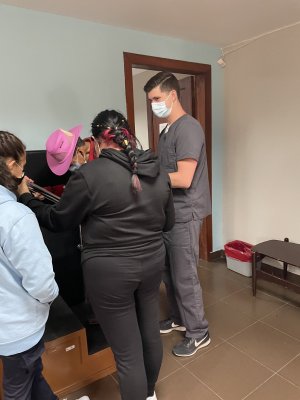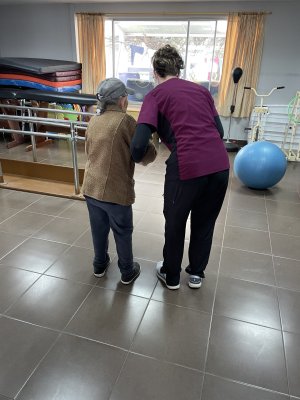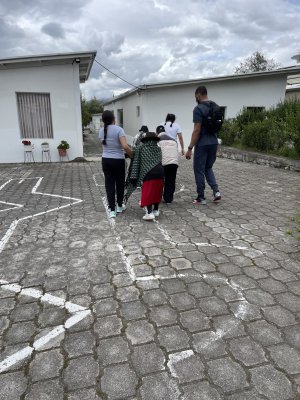Translating, Physical Therapy, and Working Outside of My Comfort Zone
I have to admit, I was nervous. As I stood by the medical center in the crisp morning air and watched students continue to file out of a charter bus, my pulse increased. I was tasked to act as a translator for a group of physical therapy (“PT”) students from another University in Indiana and between my limited Spanish skills (especially in medical terms) and pressure to make sure what was being said was communicated effectively on both sides, the responsibility being the “bridge” as my boss told me, I felt as hesitant as I have been on SST.
This was my second week of service in the province of Imbabura, about an hour north of Quito. The previous week, I was working in a home for children who can’t live with their parents because of situations of abuse, violence, neglect, etc. I had been helping in the kitchen in the mornings and hanging out with the kids in the afternoon which felt pretty low-stakes language-wise. The kids are always patient in figuring out what I’m trying to say, so I didn’t feel pressure for my Spanish to be perfect. When my boss, Esther, asked me to help translate for a group of students from Indiana, I was, on the one hand, flattered she thought I could handle it, but on the other hand, filled with mixed emotions. What if my Spanish wasn’t good enough? What if I spaced out (which happens a lot) and I miss something important? Am I ready to see other people from the U.S and speak English? Will speaking English for a week impede my Spanish immersion experience?
It turns out, however, that I had very little to worry about. My first-day translating was actually an amazing example of the way human interaction can transcend language barriers. I thankfully didn’t have to do any translation in front of a large group. It was pretty much just one-on-one between the PT students and the patients. The group of students I was with went to a geriatric center the first day, where elderly people live because they don’t have any family to take care of them. The majority have disabilities, whether with hearing, eyesight, mental, or other physical disabilities. I helped translate some, but the PT students were able to communicate a lot through motions and basic questions in Spanish about how they were feeling and where their pain was that I helped teach them. Later, a group of nursing students from Quito also came to observe and help out. The interaction between them and the PT students was especially cool, because as one PT student remarked to me “we may not speak the same language, but we speak the same language if you know what I mean.” Because the Quito students also had some understanding of physical therapy, they were able to serve as translators for the elderly folks, even though they couldn’t understand exactly what was being said in English. It was a beautiful example of our abilities to communicate with more than just words and gave me a lot of respect for both groups of students.

PT student teaches an elderly man some stair exercises while nursing students from Quito observe and assist.
I ended up translating for the group for the rest of the week and had a lot of fun getting to know the PT students. We joked that I could be certified in physical therapy now. Translating did bring its challenges later on in the week, though, especially Wednesday. We were in the mountains at a medical center and were told we had 100 patients to see in 5 hours. I had to do a lot of one-on-one translating again, but this situation was very different from the residential geriatric facility, where the PT students had pretty much just been doing workshops. Instead, we were actually doing more screening and seeing a lot of older indigenous people who had a lot of physical health struggles from years of hard labor, and a lot who lived alone. Translating for these patients was much harder because their stories were much more personal. There was one man who clearly had very bad prostate cancer and was in so much pain, and his wife kept asking me if we had any remedy. I know it was difficult for me and the students to see people in so much pain, and know that there was very little we were equipped to do about it. This type of translation also required a certain type of nuance that just knowing the words in Spanish couldn’t convey. For example, the team I was working with had one patient who they were trying to get to do a resistance test (the PT would push down on her arm and she was supposed to push up). I tried my best to explain to her what to do, and we kept giving her demonstrations, but she still didn’t understand. She kept telling me that the pain was in her elbow, not the part of the arm where they were trying to gauge her strength. My best assessment of the situation is that she had never had to do something like that before (whereas most of us probably have) and so she didn’t understand the why and was also feeling unheard because she kept emphasizing that her pain wasn’t there. I wish I was able to better explain to her what they were trying to do and I also realized how much I relied on the ability of other patients to intuitively sense what to do and mimic movements when dealing with a language barrier.

PT student works with a woman on leg-strengthening exercises.
While this week was fun, it definitely ruled out “translator” from my future career path. Translating truly takes so much nuance and sensitivity, and there is a lot of deciding what to include and what to exclude in your translation. It also requires paying a lot of attention to the person speaking, all of the time, and keeping track of what that person said to relay it back to your audience. I’m genuinely not sure I have the attention span for that. I have great respect for anyone who has to do translating on a regular basis, however, and I do think that this week was a really great learning opportunity for me, and helped to strengthen my Spanish. If anything, I’m now wishing I had gone into physical therapy.
To be completely honest, I held some assumptions about how the U.S. group of students was going to be. I didn’t expect them to be as accommodating and patient and respectful of the culture as they were. They were curious and enormously grateful to my boss, Esther, for all of her help in facilitating the trip. I’ve had some hesitation about thinking of returning to the U.S. because I often get very frustrated with the intolerance and ignorance I see expressed by some people there. But this interaction gave me hope, and also made me realize just how empowering it feels to be the one that people turn to for translation help.
Emma G.

Both PT students and Quito students pair up with residents to take a little walk after lunch, a wonderful example of cross-cultural blending.




